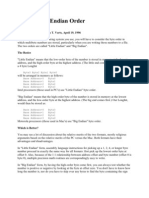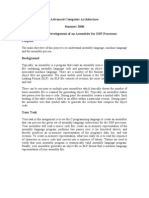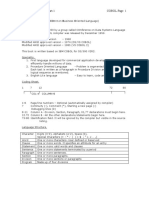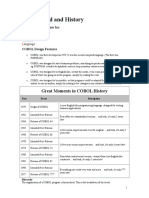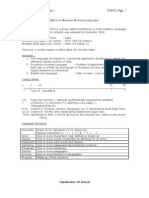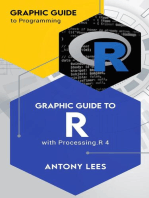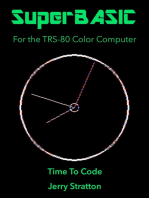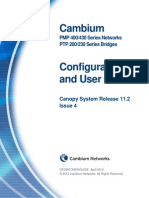PBASIC Language Basics: Dhinesh Sasidaran
Uploaded by
louiswang1964PBASIC Language Basics: Dhinesh Sasidaran
Uploaded by
louiswang1964ECEN 4213 Computer Based System Design
PBASIC Language Basics
Dhinesh Sasidaran
PBASIC INTRODUCTION
PBASIC stands for Parallax BASIC which is a variant of BASIC. This special language
has familiar BASIC instructions such as FOR..NEXT, IF..THEN and GOTO along with
some useful extra instructions that are specially for input and output (I/O). Programs can
be written using the STAMP programming software and downloaded on a serial port to
the BASIC Stamp.
YOUR FIRST STAMP PROGRAM
You can use the DEBUG command to print values to the debugging terminal managed by
the STAMP programming software. The command allows you to view variables or track
the flow of execution through your program. Run the parallax software and write the fol-
lowing program in the STAMP editor window:
‘{$STAMP BS2}
DEBUG “My first STAMP Program!”
END
Run your program. A window should pop up and you should see the debugging message
on the screen.
What appears is what was sent from the BASIC Stamp, through the programming cable
to the PC. The first line of the program is a special comment (or directive) which indicates
which version of the Stamp is in use.
PBASIC Language Basics October 14, 2002 1
ECEN 4213 Computer Based System Design
Writing your program
Write your program using the BASIC Stamp Windows Editor as shown in Figure 1.
FIGURE 1. BASIC Stamp Windows Editor
After entering your program using the Stamp editor, select Run --> Run (or by pressing
Ctrl-R). This tokenizes your code and downloads it into the Stamp.
MEMORY MAP AND I/O
The BASIC Stamp has 32 bytes of variable RAM space arranged as shown in Figure 2.
INS/OUTS
INH/OUTH INL/OUTL
DIRS W6
DIRH DIRL B13 B12
W0 W7
B1 B0 B15 B14
W1 W8
B3 B2 B17 B16
W2 W9
B5 B4 B19 B18
W3 W10
B7 B6 B21 B20
W4 W11
B9 B8 B23 B22
W5 W12
B11 B10 B25 B24
FIGURE 2. Stamp memory map
PBASIC Language Basics October 14, 2002 2
ECEN 4213 Computer Based System Design
IDENTIFIERS
Identifiers are names that a programmer makes up when writing a program. In PBASIC,
an identifier must begin with a letter and can be composed of a combination of letters,
digits and the underscore character (_) but cannot be the same as PBASIC keywords
(reserved words) or labels. PBASIC is not case sensitive and therefore both upper case
and lower case letters can be used in an identifier.
KEYWORDS (Reserved Words)
Appendix B of the STAMP manual provides a list of PBASIC keywords. You can down-
load the manual from :
(www.parallaxinc.com/downloads/download_documentation.htm)
GENERAL PROGRAM FORMAT
1. Labels
You can place labels in your program to identify a particular spot that your program has
to jump to. Labels are identified by colons (:) proceeding the label name.
2. Variables
The VAR keyword is used to specify a variable along with the size of the variable. The
VAR keyword causes the Stamp II programming software to reserve a register based
on the size specified. Before you use a variable in your program, you will need to
declare it. PBASIC however does have predefined variables that you can use without
first declaring them in your program. These are general-purpose variables with defined
names.
W0 through W12
B0 through B25 (where B0 is the lower byte of W0 and B1 is the high byte of W0)
However, it is recommended that you avoid using fixed variables in most situations and
let the PBASIC arrange the variables into the registers as it sees fit to make optimal
use of memory.
For example:
counter VAR byte
This command selects one of the byte-sized registers to be assigned to the variable
named counter. The sizes of the variable can vary from WORD, BYTE, NIB (nibble) or
BIT.
Dog VAR BIT ‘Value can be 0 or 1
Cat VAR NIB ‘Value can be 0 to 15
Dolphin VAR BYTE ‘Value can be 0 to 255
Whale VAR WORD ‘Value can be 0 to 65535
PBASIC Language Basics October 14, 2002 3
ECEN 4213 Computer Based System Design
Variables should be assigned by determining the largest value that will ever be stored
in it. The smallest size with respect to that should be chosen for the variable.
Aliases for variables can also be created using the VAR command. For example:
counter VAR BYTE
countodd VAR counter
In the lines above, countodd is an alias to the variable counter. Anything stored in
counter shows up in countodd and vice versa. Both names will refer to the same phys-
ical address.
You can also use the alias as a window into a portion of another variable. This is done
using “modifiers”. For example:
Whale VAR WORD ‘A 16-bit variable
Dolphin VAR Whale.HIGHBYTE ‘Highest 8 bits of Whale
Shark VAR Whale.LOWBYTE ‘Lowest 8 bits of Whale
The following table lists the modifiers and the definition of their use with variables.
Modifiers Definition
LOWBYTE Low byte of a word
HIGHBYTE high byte of a word
BYTE0 byte 0 (low byte) of a word
LOWNIB low nibble of word or byte
HIGHNIB high nibble of word or byte
NIB0 nib 0 of a word or byte
NIB1 nib 1 of a word or byte
NIB2 nib 2 of a word
NIB3 nib 3 of a word
LOWBIT low bit of a word, byte, or nibble
HIGHBIT high bit of a word, byte, or nibble
BIT0 bit 0 of a word, byte, or nibble
BIT1 bit 1 of a word, byte, or nibble
BIT2 bit 2 of a word, byte, or nibble
BIT3 bit 3 of a word, byte, or nibble
BIT4 ... BIT7 bits 4 through 7 of a word or byte
BIT8 ... BIT15 bits 8 through 15 of a word
3. Array variables
You can also declare arrays using the VAR command. An array has multiple items of
the same type. The following command is used to declare an array with a list of 3
bytes.
PBASIC Language Basics October 14, 2002 4
ECEN 4213 Computer Based System Design
myarray VAR byte(3)
This command creates a 3 byte-sized element array. With the abovementioned decla-
ration, the following assignments could be made:
myarray(0) = 1
myarray(1) = 10
myarray(2) = 100
Using an array without the specified index will cause the software to respond with/to
the 1st element in the array.
4. Input/Output direction
The direction of input and output pins on the Stamp can be controlled by setting the
appropriate bits in the DIRS register: a ‘1’ indicates an output pin and a ‘0’ indicates an
input pin. For example:
dirs = $F000
this is equivalent to setting I/O pins 15:12 as output pins while pins 11:0 are designated
as input pins.
Separate registers are provided for input (INS) and output (OUTS) and can be
assigned separately (IN0 or OUT1).
The OUTS register remembers what is written into it even if some of the bits are not
outputs to begin with at that time. When the DIRS register changes the directions of
those bits to outputs, the output pin will use the value that exists in the OUTS register.
5. Math expressions
Math operations are performed from left to right. There are no operator precedence
rules except when it comes to UNARY and BINARY operators. Unary operators are
given precedence in math calculations. For example:
10 - SQR 16
The BASIC Stamp first takes the square root of 16 and then subtracts it from 10.
In the case of binary operators, the expression:
5+3*2
will yeild the result 16 and not 11. Therefore, for proper calculation, the parentheses
character can be placed in the expression.
5 + (3 * 2) = 11
Note: Only 8 levels of parentheses are allowed in your math expressions.
Math expressions can also be used when dealing with input and output pins. For
example:
B1 = 10
INPUT B1+1 ‘Make pin 11 an input pin
6. Constants
Constants can be specified using the CON keyword. For example:
delay CON 1000
Constants can also be defined in terms of another constant but must be kept fairly sim-
ple. For example
PBASIC Language Basics October 14, 2002 5
ECEN 4213 Computer Based System Design
Whale CON 20
Dolphin CON Whale*2-1
NUMBERS
PBASIC allows you to use several numbering systems. By default, it assumes that num-
bers are in decimal, but you can identify binary and hexadecimal numbers with a prefix.
99 decimal
%1010 binary
$FE hex
BASIC Stamp performs integer match (whole numbers only) and drops any fractional por-
tion from the results of the computation. The size of the variables can be a bit (0-1), nibble
(0-15), byte (0-255) or word (0-65535) respectively.
For negative numbers, two’s complement math can be used for representation.
Negative Numbers
When the Stamp performs calculations, if the value is greater than the size of the variable,
then it just chops off the extra bits from left to right to form the appropriate size. For exam-
ple:
When adding $64 to $FFDF (DEC 100 and -33), the result would be $10043 but the
Stamp chops the extra bit(s) off, leaving the result to be $0043 = 67.
Adding 2 large numbers
Sometimes there may be a need to add or subtract large numbers depending on the
application. In order to do this, we can concatenate (not physically) several registers
together. For example, suppose we wish to add 2, 32 bit numbers together:
Add: W1:W2 + W3:W4
W1 = $2
W2 = $FFFF
W3 = 0
W4 = 1
W1:W2 0002 FFFF overflow results in this word (W2) being
less than the original W2
W3:W4 0000 0001
W1:W2 0003 0000
Add 1 to W1 (or W3) before adding words
W1 and W3 together.
PBASIC Language Basics October 14, 2002 6
ECEN 4213 Computer Based System Design
Program Example 1:
W1 = $2
W2 = $FFFF
W3 = 0
W4 = 1
W5 = W2 ‘temporary storage for W2
W2 = W2 + W4
IF W2 >= W5 then nocy ‘if W2 < (old) W2
W1 = W1 + 1
nocy:
W1 = W1 + W3
Subtracting 2 large numbers
Subtract: W1:W2 - W3:W4
W1 = 0
W2 = 1
W3 = $2
W4 = $FFFF
underflow results in this word (W2) being
more than the original W2
W1:W2 0000 0001
W3:W4 0002 FFFF
W1:W2 FFFD 0002
Subtract 1 from W1 (or W3) before subtracting
word W3 from W1.
Program Example 2:
W1 = 0
W2 = 1
W3 = $2
W4 = $FFFF
W5 = W2 ‘temporary storage for W2
W2 = W2 - W4
IF W2 <= W5 then nobor ‘if W2 > (old) W2
PBASIC Language Basics October 14, 2002 7
ECEN 4213 Computer Based System Design
W1 = W1 - 1
nobor:
W1 = W1 - W3
Multiplying 2 large numbers
Multiplying 2 16 bit numbers requires a 32 bit result. The ‘*’ and ‘**’ operators can be used
for this purpose.
* --> returns value of bottom 16 bits
** --> returns value of top 16 bits
For example:
Multiplication of $FFFF and $FFFF produces the result $FFFE0001
W1 = $FFFF
W2 = $FFFF
W3 = W1 * W2
W4 = W1 ** W2
Non-integer numbers
The BASIC Stamp can only handle whole integer numbers. Therefore, methods of con-
version to integer numbers is necessary depending on your exact needs. For the expres-
sion:
F = 1.8 * C + 32
can be re-written as
F = 18 * C + 320
This conversion however means that the actual result 1/10th of the result obtained from
the calculation.
One way to deal with fractional numbers is to use the ‘ */ ’ operator. It has the effect of
multiplying a value by a whole number and a fraction. This operator places the whole
number portion in the upper byte, multiplies the fractional part by 256 and places the
result in the lower byte.
For example, if multiplying value with 1.8, using the ‘ */ ’ would mean 0.8 * 256 = 204.8 =
205 and therefore:
Upper byte : 01
Lower byte : CD
so 1.8 can be represented as $01CD. Therefore, some care will need to be taken when
dealing with non-integer numbers.
Now, F = 1.8 * C + 32 can be re-written as F = C */ $01CD + 32
PBASIC Language Basics October 14, 2002 8
You might also like
- Assembly Programming:Simple, Short, And Straightforward Way Of Learning Assembly LanguageFrom EverandAssembly Programming:Simple, Short, And Straightforward Way Of Learning Assembly Language5/5 (2)
- Red Seal Sample Examination Questions - Red Seal Construction Electrician PDF100% (1)Red Seal Sample Examination Questions - Red Seal Construction Electrician PDF2 pages
- Cobol (Common Business Oriented Language) : HistoryNo ratings yetCobol (Common Business Oriented Language) : History54 pages
- M800-M80-E80 Series Maintenance Manual Ib1501273enghNo ratings yetM800-M80-E80 Series Maintenance Manual Ib1501273engh224 pages
- P1 Gen 2, X1 Extreme and X1 Extreme 2nd Hardware Maintenance ManualNo ratings yetP1 Gen 2, X1 Extreme and X1 Extreme 2nd Hardware Maintenance Manual115 pages
- Beginners Introduction to the Assembly Language of ATMEL AVR Microprocessors - CalculationsNo ratings yetBeginners Introduction to the Assembly Language of ATMEL AVR Microprocessors - Calculations22 pages
- Comparing Registers: MIPS vs. ARM AssemblyNo ratings yetComparing Registers: MIPS vs. ARM Assembly12 pages
- Byte3 Byte2 Byte1 Byte0 Base Address+0 Byte0 Base Address+1 Byte1 Base Address+2 Byte2 Base Address+3 Byte3No ratings yetByte3 Byte2 Byte1 Byte0 Base Address+0 Byte0 Base Address+1 Byte1 Base Address+2 Byte2 Base Address+3 Byte33 pages
- Advanced Computer Architecture Summer 2006 Design and Development of An Assembler For DSP Processor PurposeNo ratings yetAdvanced Computer Architecture Summer 2006 Design and Development of An Assembler For DSP Processor Purpose8 pages
- 10 Microprocessor Systems Lecture No 10 Defining DataNo ratings yet10 Microprocessor Systems Lecture No 10 Defining Data22 pages
- Assembly Language Programming - CS401 Power Point Slides Lecture 03No ratings yetAssembly Language Programming - CS401 Power Point Slides Lecture 0324 pages
- ARM Assembly Programming Using Raspberry Pi GUI PDFNo ratings yetARM Assembly Programming Using Raspberry Pi GUI PDF23 pages
- Chapter 4.1 Introduction To Assembly LanguageNo ratings yetChapter 4.1 Introduction To Assembly Language46 pages
- Siemens Siemens Siemens Siemens: LOGO! ..0BA7 in Master/master OperationNo ratings yetSiemens Siemens Siemens Siemens: LOGO! ..0BA7 in Master/master Operation8 pages
- Red Pitaya - FPGA Ebook Part 2 - Basics of Verilog FPGA Programming LanguageNo ratings yetRed Pitaya - FPGA Ebook Part 2 - Basics of Verilog FPGA Programming Language16 pages
- Introduction To VHDL Code Structure: From Pedroni, Circuit Design With VHDL, MIT Press, 2004No ratings yetIntroduction To VHDL Code Structure: From Pedroni, Circuit Design With VHDL, MIT Press, 200415 pages
- The Parts of An Assembly Language Program: CommentsNo ratings yetThe Parts of An Assembly Language Program: Comments4 pages
- DB2 11 for z/OS: Intermediate Training for Application DevelopersFrom EverandDB2 11 for z/OS: Intermediate Training for Application DevelopersNo ratings yet
- Learn to Code with C: Program with the world's most popular language on your Raspberry PiFrom EverandLearn to Code with C: Program with the world's most popular language on your Raspberry Pi5/5 (1)
- Graphic Guide to R with Processing.R 4: Graphic Guide to ProgrammingFrom EverandGraphic Guide to R with Processing.R 4: Graphic Guide to ProgrammingNo ratings yet
- Programmable Real-Time Unit (Pru) : Extending Functionality of Existing SocsNo ratings yetProgrammable Real-Time Unit (Pru) : Extending Functionality of Existing Socs6 pages
- Request For Dispatch Slip - UA Local 488No ratings yetRequest For Dispatch Slip - UA Local 4882 pages
- Steam Turbines: Prepared By, M.S.Steve, Assistant Professor, Amal Jyothi College of Engineering, KanjirapallyNo ratings yetSteam Turbines: Prepared By, M.S.Steve, Assistant Professor, Amal Jyothi College of Engineering, Kanjirapally27 pages
- Communication With Allen Bradley PLC De... S From The Rockwell Automation Company PDFNo ratings yetCommunication With Allen Bradley PLC De... S From The Rockwell Automation Company PDF1 page
- Communication With Allen Bradley PLC De... S From The Rockwell Automation Company PDFNo ratings yetCommunication With Allen Bradley PLC De... S From The Rockwell Automation Company PDF1 page
- Accumass Bw500: Instruction Manual May 2002No ratings yetAccumass Bw500: Instruction Manual May 2002150 pages
- Low Voltage Products: Motor Protection Relay, SPEMNo ratings yetLow Voltage Products: Motor Protection Relay, SPEM12 pages
- CISF HCM Oct 2023 Eng Official Format All Shifts RBE CompressedNo ratings yetCISF HCM Oct 2023 Eng Official Format All Shifts RBE Compressed163 pages
- Dimetra R8.2 Configuration and Administration Tasksheet (Student) v1.5 PDFNo ratings yetDimetra R8.2 Configuration and Administration Tasksheet (Student) v1.5 PDF20 pages
- Avanade - Windows Server 2003 Case StudyNo ratings yetAvanade - Windows Server 2003 Case Study5 pages
- IoT Sec 1.1 Fundamentals - IoT Security Final Exam AnswersNo ratings yetIoT Sec 1.1 Fundamentals - IoT Security Final Exam Answers29 pages
- Introduction To Computer Science I Course Syllabus: Barbara - Hecker@csueastbay - EduNo ratings yetIntroduction To Computer Science I Course Syllabus: Barbara - Hecker@csueastbay - Edu3 pages
- Cambium: PMP 400/430 Series Networks PTP 200/230 Series BridgesNo ratings yetCambium: PMP 400/430 Series Networks PTP 200/230 Series Bridges79 pages
- 2021BALLB06Sociology - Docx - Abhishek Dubey PDFNo ratings yet2021BALLB06Sociology - Docx - Abhishek Dubey PDF24 pages
- National Institute of Technology Rourkela-769008 Mid-Semester Examination, 2020No ratings yetNational Institute of Technology Rourkela-769008 Mid-Semester Examination, 20202 pages
- Townsend Labs Sphere L22 Microphone System User GuideNo ratings yetTownsend Labs Sphere L22 Microphone System User Guide59 pages
- Practical No.2 Perform The Extraction Transformation and Loading (ETL) Process To Construct The Database in The SqlserverNo ratings yetPractical No.2 Perform The Extraction Transformation and Loading (ETL) Process To Construct The Database in The Sqlserver12 pages
- ISTQB CT-GaMe SampleExam-Answers v1.0.1No ratings yetISTQB CT-GaMe SampleExam-Answers v1.0.134 pages
- Uninstall Trend Micro Office Scan Client For Windows 10 - How ToNo ratings yetUninstall Trend Micro Office Scan Client For Windows 10 - How To4 pages
- Xstamper Pre-Inked Stamp Operating ManualNo ratings yetXstamper Pre-Inked Stamp Operating Manual60 pages
- Installation and Operating Instructions Quadratic Integra 1530 Digital Metering SystemsNo ratings yetInstallation and Operating Instructions Quadratic Integra 1530 Digital Metering Systems68 pages
- License Logo Mockup On Grey Wall 16079655No ratings yetLicense Logo Mockup On Grey Wall 160796552 pages
- Assembly Programming:Simple, Short, And Straightforward Way Of Learning Assembly LanguageFrom EverandAssembly Programming:Simple, Short, And Straightforward Way Of Learning Assembly Language
- Red Seal Sample Examination Questions - Red Seal Construction Electrician PDFRed Seal Sample Examination Questions - Red Seal Construction Electrician PDF
- Cobol (Common Business Oriented Language) : HistoryCobol (Common Business Oriented Language) : History
- M800-M80-E80 Series Maintenance Manual Ib1501273enghM800-M80-E80 Series Maintenance Manual Ib1501273engh
- P1 Gen 2, X1 Extreme and X1 Extreme 2nd Hardware Maintenance ManualP1 Gen 2, X1 Extreme and X1 Extreme 2nd Hardware Maintenance Manual
- Beginners Introduction to the Assembly Language of ATMEL AVR Microprocessors - CalculationsBeginners Introduction to the Assembly Language of ATMEL AVR Microprocessors - Calculations
- Byte3 Byte2 Byte1 Byte0 Base Address+0 Byte0 Base Address+1 Byte1 Base Address+2 Byte2 Base Address+3 Byte3Byte3 Byte2 Byte1 Byte0 Base Address+0 Byte0 Base Address+1 Byte1 Base Address+2 Byte2 Base Address+3 Byte3
- Advanced Computer Architecture Summer 2006 Design and Development of An Assembler For DSP Processor PurposeAdvanced Computer Architecture Summer 2006 Design and Development of An Assembler For DSP Processor Purpose
- 10 Microprocessor Systems Lecture No 10 Defining Data10 Microprocessor Systems Lecture No 10 Defining Data
- Assembly Language Programming - CS401 Power Point Slides Lecture 03Assembly Language Programming - CS401 Power Point Slides Lecture 03
- ARM Assembly Programming Using Raspberry Pi GUI PDFARM Assembly Programming Using Raspberry Pi GUI PDF
- Siemens Siemens Siemens Siemens: LOGO! ..0BA7 in Master/master OperationSiemens Siemens Siemens Siemens: LOGO! ..0BA7 in Master/master Operation
- Red Pitaya - FPGA Ebook Part 2 - Basics of Verilog FPGA Programming LanguageRed Pitaya - FPGA Ebook Part 2 - Basics of Verilog FPGA Programming Language
- Introduction To VHDL Code Structure: From Pedroni, Circuit Design With VHDL, MIT Press, 2004Introduction To VHDL Code Structure: From Pedroni, Circuit Design With VHDL, MIT Press, 2004
- The Parts of An Assembly Language Program: CommentsThe Parts of An Assembly Language Program: Comments
- DB2 11 for z/OS: Intermediate Training for Application DevelopersFrom EverandDB2 11 for z/OS: Intermediate Training for Application Developers
- COBOL Language Fundamentals with DB2 Quick StartFrom EverandCOBOL Language Fundamentals with DB2 Quick Start
- Learn to Code with C: Program with the world's most popular language on your Raspberry PiFrom EverandLearn to Code with C: Program with the world's most popular language on your Raspberry Pi
- Graphic Guide to R with Processing.R 4: Graphic Guide to ProgrammingFrom EverandGraphic Guide to R with Processing.R 4: Graphic Guide to Programming
- COBOL Basic Training Using VSAM, IMS and DB2From EverandCOBOL Basic Training Using VSAM, IMS and DB2
- 20-Minute (Or Less) Digital Storytelling HacksFrom Everand20-Minute (Or Less) Digital Storytelling Hacks
- Programmable Real-Time Unit (Pru) : Extending Functionality of Existing SocsProgrammable Real-Time Unit (Pru) : Extending Functionality of Existing Socs
- Steam Turbines: Prepared By, M.S.Steve, Assistant Professor, Amal Jyothi College of Engineering, KanjirapallySteam Turbines: Prepared By, M.S.Steve, Assistant Professor, Amal Jyothi College of Engineering, Kanjirapally
- Communication With Allen Bradley PLC De... S From The Rockwell Automation Company PDFCommunication With Allen Bradley PLC De... S From The Rockwell Automation Company PDF
- Communication With Allen Bradley PLC De... S From The Rockwell Automation Company PDFCommunication With Allen Bradley PLC De... S From The Rockwell Automation Company PDF
- Low Voltage Products: Motor Protection Relay, SPEMLow Voltage Products: Motor Protection Relay, SPEM
- CISF HCM Oct 2023 Eng Official Format All Shifts RBE CompressedCISF HCM Oct 2023 Eng Official Format All Shifts RBE Compressed
- Dimetra R8.2 Configuration and Administration Tasksheet (Student) v1.5 PDFDimetra R8.2 Configuration and Administration Tasksheet (Student) v1.5 PDF
- IoT Sec 1.1 Fundamentals - IoT Security Final Exam AnswersIoT Sec 1.1 Fundamentals - IoT Security Final Exam Answers
- Introduction To Computer Science I Course Syllabus: Barbara - Hecker@csueastbay - EduIntroduction To Computer Science I Course Syllabus: Barbara - Hecker@csueastbay - Edu
- Cambium: PMP 400/430 Series Networks PTP 200/230 Series BridgesCambium: PMP 400/430 Series Networks PTP 200/230 Series Bridges
- National Institute of Technology Rourkela-769008 Mid-Semester Examination, 2020National Institute of Technology Rourkela-769008 Mid-Semester Examination, 2020
- Townsend Labs Sphere L22 Microphone System User GuideTownsend Labs Sphere L22 Microphone System User Guide
- Practical No.2 Perform The Extraction Transformation and Loading (ETL) Process To Construct The Database in The SqlserverPractical No.2 Perform The Extraction Transformation and Loading (ETL) Process To Construct The Database in The Sqlserver
- Uninstall Trend Micro Office Scan Client For Windows 10 - How ToUninstall Trend Micro Office Scan Client For Windows 10 - How To
- Installation and Operating Instructions Quadratic Integra 1530 Digital Metering SystemsInstallation and Operating Instructions Quadratic Integra 1530 Digital Metering Systems
















